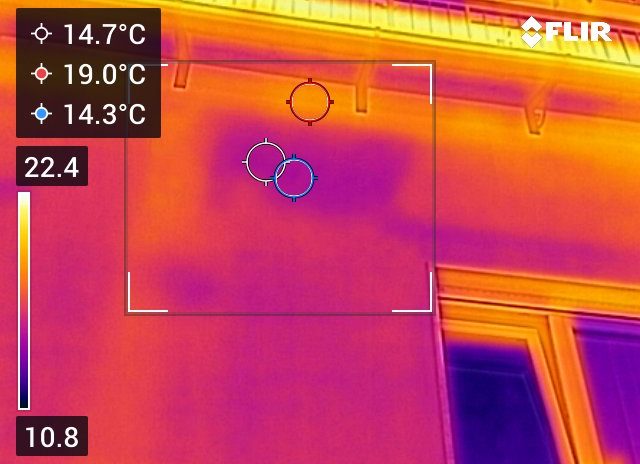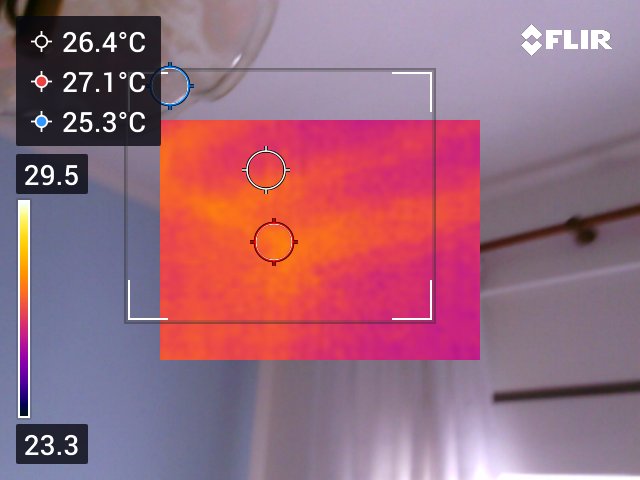LA TERMOGRAFIA
Thermography
- 29 Ott 2023

La termografia può essere definita come metodologia di analisi qualitativa basata sull’elaborazione di termogrammi.
È una Tecnica diagnostica non distruttiva che, misura la radiazione infrarossa emessa dai corpi, è quindi in grado di determinarne la temperatura superficiale. Ciò significa che genera immagini di trasferimenti di calore, non di temperature.
Rileva le radiazioni termiche emesse dagli oggetti e le converte in una immagine bidimensionale con la possibilità di assegnare colori diversi alle diverse temperature “apparenti”.
I vantaggi della termografia sono:
- È una tecnica non invasiva, molto utile quando non si deve in alcun modo danneggiare la struttura.
- È una tecnica rapida che può dare risultati efficaci in breve tempo.
- È una tecnica agevole da usare, che permette in molti casi di effettuare diagnosi veloci senza bisogno di attrezzature voluminose.
Gli svantaggi sono:
- L’indagine è di tipo qualitativo, in quanto viene misurata la radiazione termica della parte più esterna.
- Vi è una influenza molto importante delle condizioni climatiche, soprattutto per evidenziare alcune problematiche, è necessario quindi programmare le battute in base alle stagioni ed all’orario.
- Per evidenziare le irregolarità termiche sotto lo strato corticale, è necessario agire in stato transitorio (riscaldamento o raffreddamento).
- Si tratta di una tecnica semplice ma di non facile utilizzo in quanto occorre esperienza e perizia sia nell’acquisire che nell’elaborare i termogrammi.
Per la rilevazione e la elaborazione della documentazione relativa alle indagini effettuate è necessario fare riferimento ad alcune normative tra le quali le più importanti sono:
- UNI EN 10824-1:2000 Prove non distruttive – Termografia all’infrarosso – Termini e definizioni.
- UNI EN 13187:2000 Prestazione termica degli edifici -Rivelazione qualitativa delle irregolarità termiche negli involucri edilizi –Metodo all’infrarosso
- UNI EN 473:2008 Prove non distruttive –Qualificazione e certificazione del personale addetto alle prove non distruttive –Principi generali
- ISO 18436-1/3/7 Monitoraggio e diagnostica delle macchine-Requisiti per la qualificazione e la valutazione del personale
Parte 1: Requisiti per la certificazione e il processo di certificazione
Parte 3 : Requisiti per istituti di formazione e di formazione
Parte 7: Termografia
L’uso della termografia ha applicazione in disparati campi, per quanto riguarda l’edilizia, una ispezione termografica degli edifici può risolvere diverse problematiche:
- Supporto alla riqualificazione e alla certificazione energetica mediante la verifica delle dispersioni dell’involucro edilizio, l’individuazione di presenza di acqua e muffe.
- Aumento della conoscenza strutturale mediante l’individuazione della tessitura muraria e degli elementi strutturali piuttosto che le differenze di materiale o vuolti e bucature.
- Indagini sugli impianti atte ad evidenziare problemi sugli impianti elettrici e di riscaldamento piuttosto che individuare rotture nelle tubazioni o semplicemente determinarne il punto di passaggio.
Il principio fisico su cui si basa la termografia è che ogni corpo avente una temperatura superiore a 0 K (-273,15 °C) emette delle radiazioni termiche sotto forma di onde elettromagnetiche, definite “infrarosso”. La termocamera è equipaggiata di un sensore che riesce a captare l’infrarosso come il sensore di una fotocamera digitale capta le radiazioni visibili. Prima di arrivare alla termocamera, le radiazioni infrarosse devono attraversare l’atmosfera compresa tra l’oggetto da termografare e la termocamera. L’atmosfera non è permeabile allo stesso modo alle varie lunghezze d’onda delle radiazioni per cui si considerane due finestre tra 3 e 5 micron e tra 8 e 12 micron. Le termocamere più usate in campo edile hanno un range tra gli 8 e i 12 micron.

Un importante parametro da tenere in considerazione è il “Coefficiente di Emissività”, ogni corpo che emette infrarossi a sua volta li riceve dall’ambiente esterno, una parte li assorbe, una parte li riflette. Nell’effettuare il termogramma dobbiamo registrare gli infrarossi che vengono emessi dal corpo, non quelli che riflette, diventa quindi importante sapere la percentuale degli infrarossi riflessa. Ogni materiale si comporta in maniera diversa, ci sono delle tabelle che possono esserci di aiuto per stabilire questo parametro. Un corpo nero (teorico) assorbe tutte le radiazioni infrarosse senza riflettere niente, ha quindi un Coefficiente di Emissività pari a 1, ciò significa che i corpi reali hanno tutti CE <1. Per esempio un intonaco di gesso ha un CE di 0,92, ciò significa che assorbe il 92% della radiazione infrarossa e ne riflette l’8%, questo parametro va impostato sulla termocamera per il corretto rilevamento del termogramma.
I componenti principali di una termocamera sono:
- Il gruppo ottico costruito in germanio, materiale che non assorbe radiazioni infrarosse. La qualità dell’ottica è importante per la nitidezza dell’immagine e la messa a fuoco.
- Il sensore che capta le radiazioni ed è caratterizzato da due caratteristiche, il numero dei pixel che determina la risoluzione geometrica e la risoluzione termica cioè, la minima differenza di temperatura che il sensore riesce a rilevare tra due punti adiacenti.
- L’elettronica e il software che elaborano i dati e li trasferiscono allo schermo con la possibilità di salvare i termogrammi.

Esistono poi dei software, generalmente forniti dalle case costruttrici delle termocamere che permettono l’editing e l’organizzazione dei termogrammi.
La maggior parte delle impostazioni della termocamera possono essere modificate in corso di editing, solo una, il fuoco dell’immagine, può essere impostato solo in corso di ripresa. Una immagine sfuocata, non solo denota scarsa professionalità ma, falsa anche il rilievo termografico producendo risultati errati. Difficilmente si riesce a inserire tutta una immagine in un unico scatto, quindi, una volta messi alla distanza giusta, misurata, bisogna fare più scatti, facendo una sequenza che poi va unita in corso di editing. Si consiglia di accavallare abbastanza i margini in modo da poterli più facilmente sovrapporre.
 Pasquale Marottoli – ZEDPROGETTI srl
Pasquale Marottoli – ZEDPROGETTI srl
Thermography can be defined as a methodology of qualitative analysis based on the elaboration of thermograms.
It is a non-destructive diagnostic technique that measures the infrared radiation emitted by bodies and is therefore able to determine their surface temperature. This means that it generates images of heat transfers, not temperatures.
It detects the thermal radiation emitted by objects and converts it into a two-dimensional image with the possibility of assigning different colours to different “apparent” temperatures.
The advantages of thermography are:
– It is a non-invasive technique, very useful when there is no need to damage the structure in any way.
– It is a rapid technique that can give effective results in a short time.
– It is an easy to use technique, which allows in many cases to make quick diagnoses without the need for voluminous equipment.
The disadvantages are:
– The investigation is qualitative, as the heat radiation of the outermost part is measured.
– There is a very important influence of climatic conditions, especially to highlight some problems, it is therefore necessary to program the beats according to the seasons and time.
– To highlight thermal irregularities under the cortical layer, it is necessary to act in a transitory state (heating or cooling).
– This is a simple technique but not easy to use as it requires experience and expertise both in acquiring and processing thermograms.
For the detection and processing of the documentation relating to the surveys carried out it is necessary to refer to some regulations among which the most important are:
– UNI EN 10824-1:2000 Non-destructive testing – Infrared thermography – Terms and definitions.
– UNI EN 13187:2000 Thermal performance of buildings – Qualitative detection of thermal irregularities in building envelopes – Infrared method
– UNI EN 473:2008 Non-destructive testing -Qualification and certification of non-destructive testing personnel – General principles
– ISO 18436-1/3/7 Monitoring and diagnostics of machinery – Requirements for qualification and assessment of personnel
Part 1: Requirements for certification and certification process
Part 3 : Requirements for training and educational institutions
Part 7: Thermography
The use of thermography has applications in many different fields, as far as the construction industry is concerned, a thermographic inspection of buildings can solve various problems:
– Support to the requalification and energy certification through the verification of the dispersion of the building envelope, the detection of the presence of water and mold.
– Increased structural knowledge through the identification of the masonry texture and structural elements rather than the differences in material or intensions and holes.
– Investigations on the systems to highlight problems on electrical and heating systems rather than identifying breakages in the pipes or simply determining the point of passage.
The physical principle on which thermography is based is that any body with a temperature above 0 K (-273.15 °C) emits thermal radiation in the form of electromagnetic waves, called “infrared”. The thermal imaging camera is equipped with a sensor that can pick up infrared like a digital camera’s sensor picks up visible radiation. Before arriving at the thermal imaging camera, the infrared radiation must pass through the atmosphere between the object to be thermographed and the thermal imaging camera. The atmosphere is not permeable in the same way to the various wavelengths of radiation so consider two windows between 3 and 5 microns and between 8 and 12 microns. The most commonly used thermal imaging cameras in the construction field have a range between 8 and 12 microns.
An important parameter to take into account is the “Emissivity Coefficient”, every body that emits infrared in turn receives them from the external environment, a part absorbs them, a part reflects them. In making the thermogram we must record the infrared that is emitted by the body, not the one that reflects, so it becomes important to know the percentage of reflected infrared. Each material behaves differently, there are tables that can help us to establish this parameter. A black body (theoretical) absorbs all the infrared radiation without reflecting anything, so it has an Emission Coefficient equal to 1, this means that the real bodies all have CE <1. For example a gypsum plaster has a CE of 0.92, this means that it absorbs 92% of the infrared radiation and reflects 8% of it, this parameter should be set on the thermal imaging camera for correct thermogram detection.
The main components of a thermal imaging camera are:
– The optical unit made of germanium, a material that does not absorb infrared radiation. The quality of the optics is important for image sharpness and focus.
– The sensor captures radiation and is characterized by two characteristics, the number of pixels that determines the geometric resolution and the thermal resolution, that is, the smallest temperature difference that the sensor can detect between two adjacent points.
– The electronics and software that process the data and transfer it to the screen with the possibility to save the thermograms.
There is also software, generally provided by the manufacturers of thermal imaging cameras that allows the editing and organization of thermograms.
Most camera settings can be changed during editing, only one, the focus of the image, can only be set during shooting. A blurred image not only shows a lack of professionalism but also distorts the thermographic survey and produces incorrect results. It is difficult to insert an entire image in a single shot, so once you put it at the right distance, measured, you have to take several shots, making a sequence that is then joined during editing. It is advisable to overlap the margins enough so that they can be more easily superimposed.

